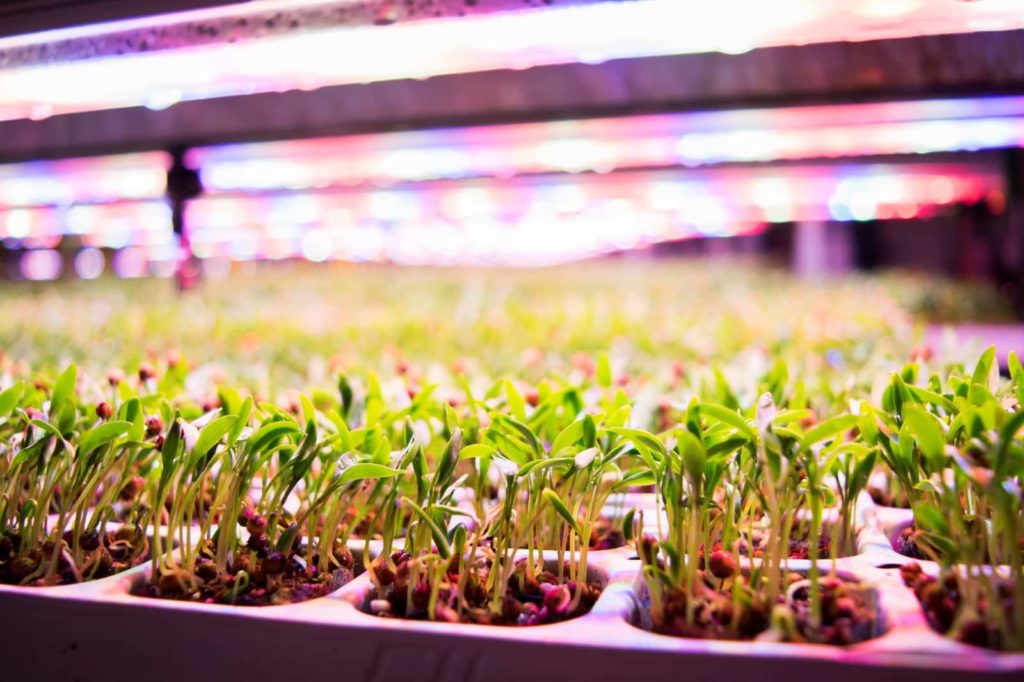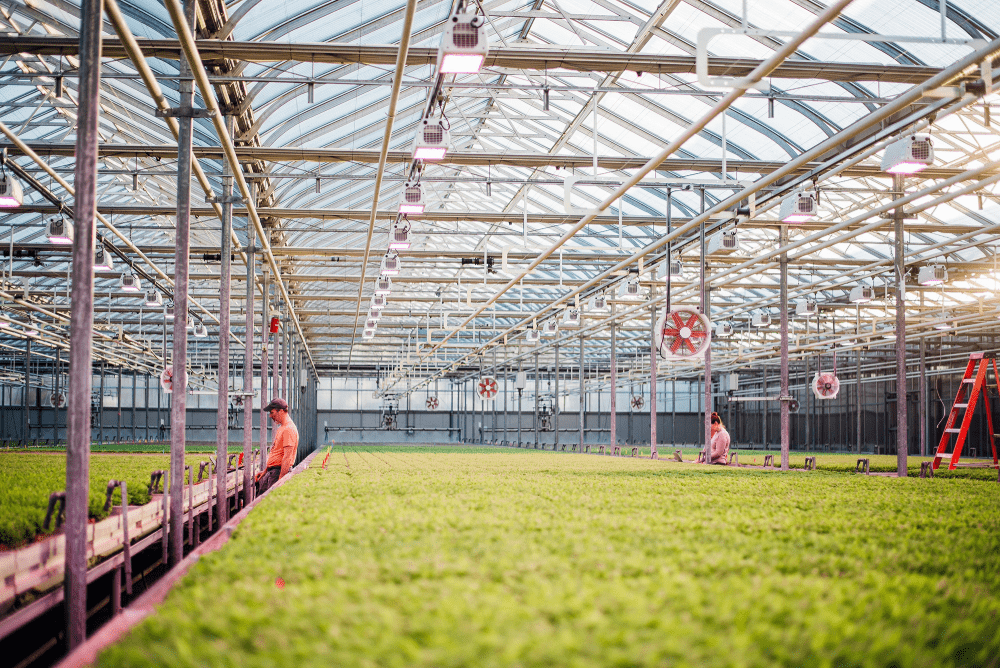Food
Research
Vertical Farming
The importance of light quality
For a commercial grower even a small difference in plant growth performance can have significant impact on profit. Since plant growth is driven by light, it is important to provide the right lighting for your production. Before LED commercial grow lights became available and competitive on the market, the possibilities were limited, as the grower could only decide for supplemental light intensity and not light quality (i.e. spectrum: color or wavelength distribution of the artificial light). LED technology changed everything. There is no such thing as a ”standard LED” since horticultural LEDs come in different colours and can be used in multiple combinations, varying in spectra characteristics and the amount of photons commonly within blue, green, red, and far-red (FR) wavebands.
What is the best light spectrum to grow plants?
Over the past decades, researchers at various universities, agtech companies and horticultural lighting suppliers have tried to understand how plants capture and use light and how they respond to different color composition, i.e. spectral quality of light. The work has not completed, but we have learned that plants grow best in the light similar to natural sunlight. Seems obvious, right? But the details are not trivial.
Narrow spectrum
At first, many scientists believed that using only red and blue light could increase the efficacy of photosynthesis. The green pigments, chlorophyll, primarily used by plants to capture light, have peaks of absorption in the red and blue regions (i.e. they capture mostly blue and red photons). But we are not growing chlorophyll, neither single leaves. Therefore, it is of essence to understand how whole plants, often with complicated structures, capture light.
Some LED grow lights are only using a combination of blue and red LEDs. This type of light source usually has the highest photon efficacy, meaning the lights convert electric energy to a larger number of photons. These LEDs are also efficient for driving plant photosynthesis, but mainly on top leaves. Because red and blue light is absorbed so efficiently, almost all available photons are used at the top of the canopy. Plants grown under blue and red light are often very compact and light does not penetrate deeper into the canopy. The lower leaves will, in such condition, not receive enough light and can start to die. Therefore, this type of narrow spectrum grow light can be useful for certain applications. It does not, however, provide a good lighting environment to support natural development of larger plants.
Full spectrum
Full spectrum grow lights are luminaires which emit light containing photons from the entire spectral region, which is used by plants (i.e. at least 350-750nm). The term “full spectrum” is often mis-communicated by horticulture light producers, and many full spectrum grow lights available in the market emit light covering only photosynthetically active radiation (PAR) while omitting UV and short blue wavelengths. And they often contain only a small amount of far-red. Therefore, they can be more correctly termed as broad spectrum lights.
Any well-balanced broad or full spectrum lights will do their job, growing healthy plants, for a full cycle providing that adequate light intensity (PFD and/or DLI) is assured. However, for best results and yield, the spectrum composition should be carefully chosen by the grower for a specific crop, growth environment and application.
Balanced broad or full spectrum is perceived by humans as white light. Therefore, using such lights in a production facility makes plants look natural and allows visual detection of leaf discoloration, diseases, or pests. It can create a work-friendly environment, but we need to look at light spectrum from the plants’ perspective first.
How light spectrum affects plants
Spectral quality usually does not have a significant direct effect on plant photosynthesis but will impact the plant morphology i.e. plants’ shape. Plant shape is of visual and commercial importance (e.g. when plants are sold in pots). Moreover, the plant’s leaf size, compact or loose arrangement, and the overall area or footprint affects how much light is captured by the plant and how much light is available inside the canopy. These factors can, in turn, affect growth rate and yield. Furthermore, quality of light influences biomass and how a plant will distribute sugars to build its stems, leaves, flowers, and fruit.
It is important to understand that different colors of light do not work independently, but in synergy. Plants generally do not perceive the percentages of photons of a given color in the light, but the ratios of different colors. Plants have several receptors which sense different wavelengths and react accordingly. These receptors are activated by one set of wavebands and deactivated by others.
It is a dynamic process, and a plant grown in balanced light has both activated and disactivated forms, in a ratio depending on spectral composition of the grow light. For example, phytochromes are a group of receptors sensitive to far-red (FR).
Far-red light is mostly responsible for extension growth of plant stems, petioles, and, in some species, leaves. It affects branching and flower production. Even though FR is not counted as a part of photosynthetically active radiation (PAR), far-red (up to 750 nm) drives photosynthesis almost as efficiently as white light, when it is used together with white light background. Providing adequate ratios of red to far-red photons for plant production can impact plant size, shape, flowering, biomass, as well as seed and fruit quality.
Red light is very efficient in driving photosynthesis. The presence of red light in a grow light spectrum balances effect of far-red as well as blue light. High proportions of red light often stimulate biomass allocation to stems.
Blue light counteracts plant leaf and stem elongation as well as stimulates production of photoprotective pigments. Plants grown with large proportions of blue light are short, compact and have relatively thick, small, and dark leaves. Blue light stimulates plant branching and may affect flower initiation and flowering. So, depending on the crop and your cultivation goals, a high proportion of blue photons in a grow light spectrum might be either desired or unwanted.
Green light in a spectrum of a LED growth light usually comes from the output of white LEDs because of the low efficacy of green LED diodes.
Leveraging UV-A and Its Impact on Plant Development
Including green light in grow light spectrum is useful not only for human vision to see plants correctly, but also promotes photosynthesis. More importantly, due to the low absorption rate of green light at the surface of the leaf, green photons, unlike red and blue photons, penetrate deeper in leaf structure and deeper into the canopy, driving photosynthesis there. Plants use 70% to 95% of green light depending on the plant species and growth stage.
Green light works opposite to blue light, stimulating increases in leaf size and influencing leaf position. Consequently, plants which are less compact can capture light form a larger area. Presence of green light can have positive effect on light penetration into the plant canopy, can increase the total amount of photons captured and stimulate yield.
Ultraviolet (UV) has shorter wavelengths and higher frequencies then light visible to humans. It is largely harmful for living organisms, but it also has biological importance. For example, it is used in the synthesis of vitamin D in human skin. Insects can see UV and therefore they are attracted to patterns on flowers not visible to humans.
UV-A is the longest waveband and to plants and humans, a least harmful waveband in the UV wavelength range. UV-A light can be used to control plant diseases and stimulate production of some biochemical compounds contributing to plant taste and aroma. Some growers use supplemental UV bulbs and some LED grow lights contain UV-A in their spectral output. However, there is a downside. The quantum efficacy of UV LEDs is low due to high energy of UV photons. Also, having UV in a spectral composition of a grow light requires special components for optics and optical covers that will not deteriorate and have high UV transmittance.
Although longer wavelengths of UV-A are photosynthetically active, plants exposed to UV light produce protective pigments, which work as sunscreen, and other biochemical compounds protecting them from excess energy. Consequently, UV light can stimulate plants coloration and biochemical properties, but biomass production and yield of plants exposed to UV is usually lower when compared to plants grown without UV.
So, does an optimal grow light exist?
There is more to understanding LED grow lights, spectra quality and light output and the effects on crop growth performance. Modern LED lighting solutions offer more efficient and high-quality crop production. The optimal grow light should be one that is developed to fit your indoor or greenhouse growing environment, geographical location and first and foremost to your specific crop and cultivation requirements, plant varieties and production cycles. To achieve best results, select a grow light solution that supports the energy needs of your plants while ensuring your desired crop characteristics and outcomes. It is always recommended to consult a specialist to help you match light quality with your cultivation requirements and goals.
Get in touch with us!
From custom light planning, to tailored quotes, and everything in between,
our team of horticulture experts are always ready to assist.






